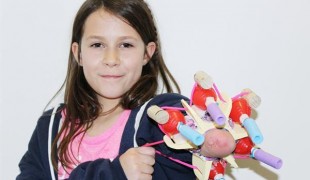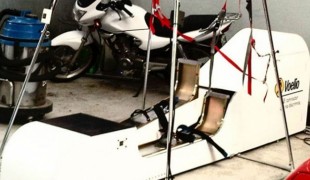- 17281
- 886
- 22
- 32
- 0
- Help Ukraine
About the solution
This disease cost the girl the use of her arm, although she can move her hand and wrist.
Bodo, who has a background in computing, created a 3D printed robotic arm brace that his helping his daughter move and has increased her chances of rehabilitation.
“Over the last several weeks she has now slowly started to regain the use of her arm and is able to move!”, the inventor explained.
The father was told that traditional treatments would have given Lorelei about a 5% chance at recovery, and state of the art treatments were closed to them or were too costly. So he took the matter into his own hands, and started researching assistive devices in the form of robotic exoskeletons that have helped paralyzed or partially paralyzed people learn or relearn to use their muscles effectively.
Bodo scanned Lorelei’s arm to get her exact measurements, then designed and 3D printed two lightweight braces that would fit her forearm and upper arm. The braces would then be connected with an actuator controlled through embedded sensors. Then the father started posting videos on Youtube to get advice from the crowd.
“After a few weeks, we had a pretty good understanding of all the components we needed to get something working. With a tight budget, we went shopping… We bought an Arduino, an EKG board, various sensors and built an arm rig to test it all out on”, Bodo said.
After prototyping with different materials and getting help from volunteers from all over the world, the duo managed to train an algorithm to recognize when she was trying to move her arm, and she began practicing with the help of a virtual arm.
The final product is a robotic arm prototype that is ten times lighter and ten times less expensive than comparable technology currently being used. Bodo wants to open source the technology so that it’s available to everyone.
The instructions for building the device can already be found online.
More info: http://bit.ly/2n2rhFa
Adapted from: http://bit.ly/2n2rg4c
https://youtu.be/_pWQ_I4V-5w
This solution shall not include mention to the use of drugs, chemicals or biologicals (including food); invasive devices; offensive, commercial or inherently dangerous content. This solution was not medically validated. Proceed with caution! If you have any doubts, please consult with a health professional.
DISCLAIMER: This story was written by someone who is not the author of the solution, therefore please be advised that, although it was written with the utmost respect for the innovation and the innovator, there can be some incorrect statements. If you find any errors please contact the patient Innovation team via info@patient-innovation.com
-
-
1257
-
43
-
53357

Robohand - A 3D-printed thermoplastic mechanical hand
Grip
Studying
Limb Amputation
3d Printed
Body-Worn solutions (Clothing, accessories, shoes, sensors...)
Difficulty walking or moving
Limited range of motion
Reduced grip force (grip)
Joint deformity
Joint redness or warmth
Joint pain or swelling
Restoring mobility
Replacing lost limbs
Promoting self-management
Managing Neurological Disorders
Promoting inclusivity and social integration
Recovering from Traumatic Injuries
To improve Treatment/Therapy
Neurology
Orthopedics
Pediatrics
Vascular Surgery
United States
-
-
-
659
-
0
-
9722

Girl invents way to get new attachments for her 3D printed arm
Grip
Limb Deformity
Hand Deformity
Elbow Deformity
Prosthesis
3d Printed
Body-Worn solutions (Clothing, accessories, shoes, sensors...)
Assistive Daily Life Device (to help ADL)
Muscle weakness
Limited range of motion
Reduced grip force (grip)
Loss of muscle coordination
Restoring mobility
Replacing lost limbs
Maintaining Balance and Mobility
General and Family Medicine
Medical Genetics
Pediatrics
United States
-
-
-
510
-
0
-
9056

Father creates walking aid for his son
WALKING: Walking
WALKING WITH A WALKING AID: Walking with a walking aid
CAREGIVING
Cervical spinal cord injury/Tetraplegia
Walking Aid (wheelchair/walker/crutches)
Restoring mobility
Promoting self-management
Preserving Organ Function
Rehabilitating After Stroke
Managing Neurological Disorders
Recovering from Traumatic Injuries
Maintaining Balance and Mobility
To improve Treatment/Therapy
Raise awareness
Caregiving Support
General and Family Medicine
Internal Medicine
Neurology
Pediatrics
Physical Medicine and Rehabilitation
Argentina
-
 en
en